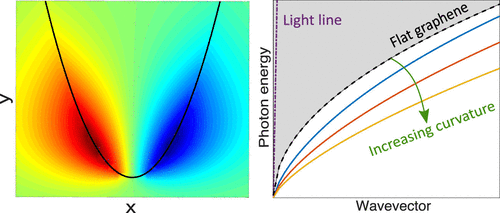当前位置:
X-MOL 学术
›
ACS Photonics
›
论文详情
Our official English website, www.x-mol.net, welcomes your
feedback! (Note: you will need to create a separate account there.)
Polaritons in Two-Dimensional Parabolic Waveguides
ACS Photonics ( IF 6.5 ) Pub Date : 2021-06-04 , DOI: 10.1021/acsphotonics.1c00481 T. P. Rasmussen 1, 2 , P. A. D. Gonçalves 1, 3 , Sanshui Xiao 4, 5 , Sebastian Hofferberth 2, 6 , N. Asger Mortensen 1, 5, 7 , Joel D. Cox 1, 7
ACS Photonics ( IF 6.5 ) Pub Date : 2021-06-04 , DOI: 10.1021/acsphotonics.1c00481 T. P. Rasmussen 1, 2 , P. A. D. Gonçalves 1, 3 , Sanshui Xiao 4, 5 , Sebastian Hofferberth 2, 6 , N. Asger Mortensen 1, 5, 7 , Joel D. Cox 1, 7
Affiliation

|
The suite of highly confined polaritons supported by two-dimensional (2D) materials constitutes a versatile platform for nano-optics, offering the means to channel light on deep-subwavelength scales. Graphene, in particular, has attracted considerable interest due to its ability to support long-lived plasmons that can be actively tuned via electrical gating. While the excellent optoelectronic properties of graphene are widely exploited in plasmonics, its mechanical flexibility remains relatively underexplored in the same context. Here, we present a semianalytical formalism to describe plasmons and other polaritons supported in waveguides formed by bending a 2D material into a parabolic shape. Specifically, for graphene parabolas, our theory reveals that the already large field confinement associated with graphene plasmons can be substantially increased by bending an otherwise flat graphene sheet into a parabola shape, thereby forming a plasmonic waveguide without introducing potentially lossy edge terminations via patterning. Further, we show that the high field confinement associated with such channel polaritons in 2D parabolic waveguides can enhance the spontaneous emission rate of a quantum emitter near the parabola vertex. Our findings apply generally to 2D polaritons in atomically thin materials deposited onto grooves or wedges prepared on a substrate or freely suspended in a quasi-parabolic (catenary) shape. We envision that both the optoelectronic and mechanical flexibility of 2D materials can be harnessed in tandem to produce 2D channel polaritons with versatile properties that can be applied to a wide range of nano-optics functionalities, including subwavelength polaritonic circuitry and bright single-photon sources.
中文翻译:

二维抛物线波导中的极化子
由二维 (2D) 材料支持的一组高度受限的极化子构成了纳米光学的多功能平台,提供了在深亚波长尺度上引导光的方法。尤其是石墨烯,因其支持长寿命等离子体激元的能力而引起了相当大的兴趣,这些等离子体激元可以通过电门控进行主动调谐。虽然石墨烯优异的光电特性在等离子体激元中得到了广泛的利用,但在相同的背景下,其机械灵活性仍然相对不足。在这里,我们提出了一种半解析形式来描述通过将二维材料弯曲成抛物线形状而形成的波导中支持的等离子体激元和其他极化激元。具体来说,对于石墨烯抛物线,我们的理论表明,通过将原本平坦的石墨烯片弯曲成抛物线形状,可以大大增加与石墨烯等离子体相关的已经很大的场限制,从而形成等离子体波导,而不会通过图案化引入潜在的有损边缘终端。此外,我们表明与二维抛物线波导中的此类通道极化子相关的高场限制可以提高抛物线顶点附近量子发射器的自发发射率。我们的发现通常适用于原子级薄材料中的 2D 极化子,这些材料沉积在衬底上制备的凹槽或楔形物上,或以准抛物线(悬链线)形状自由悬浮。
更新日期:2021-06-17
中文翻译:

二维抛物线波导中的极化子
由二维 (2D) 材料支持的一组高度受限的极化子构成了纳米光学的多功能平台,提供了在深亚波长尺度上引导光的方法。尤其是石墨烯,因其支持长寿命等离子体激元的能力而引起了相当大的兴趣,这些等离子体激元可以通过电门控进行主动调谐。虽然石墨烯优异的光电特性在等离子体激元中得到了广泛的利用,但在相同的背景下,其机械灵活性仍然相对不足。在这里,我们提出了一种半解析形式来描述通过将二维材料弯曲成抛物线形状而形成的波导中支持的等离子体激元和其他极化激元。具体来说,对于石墨烯抛物线,我们的理论表明,通过将原本平坦的石墨烯片弯曲成抛物线形状,可以大大增加与石墨烯等离子体相关的已经很大的场限制,从而形成等离子体波导,而不会通过图案化引入潜在的有损边缘终端。此外,我们表明与二维抛物线波导中的此类通道极化子相关的高场限制可以提高抛物线顶点附近量子发射器的自发发射率。我们的发现通常适用于原子级薄材料中的 2D 极化子,这些材料沉积在衬底上制备的凹槽或楔形物上,或以准抛物线(悬链线)形状自由悬浮。









































 京公网安备 11010802027423号
京公网安备 11010802027423号